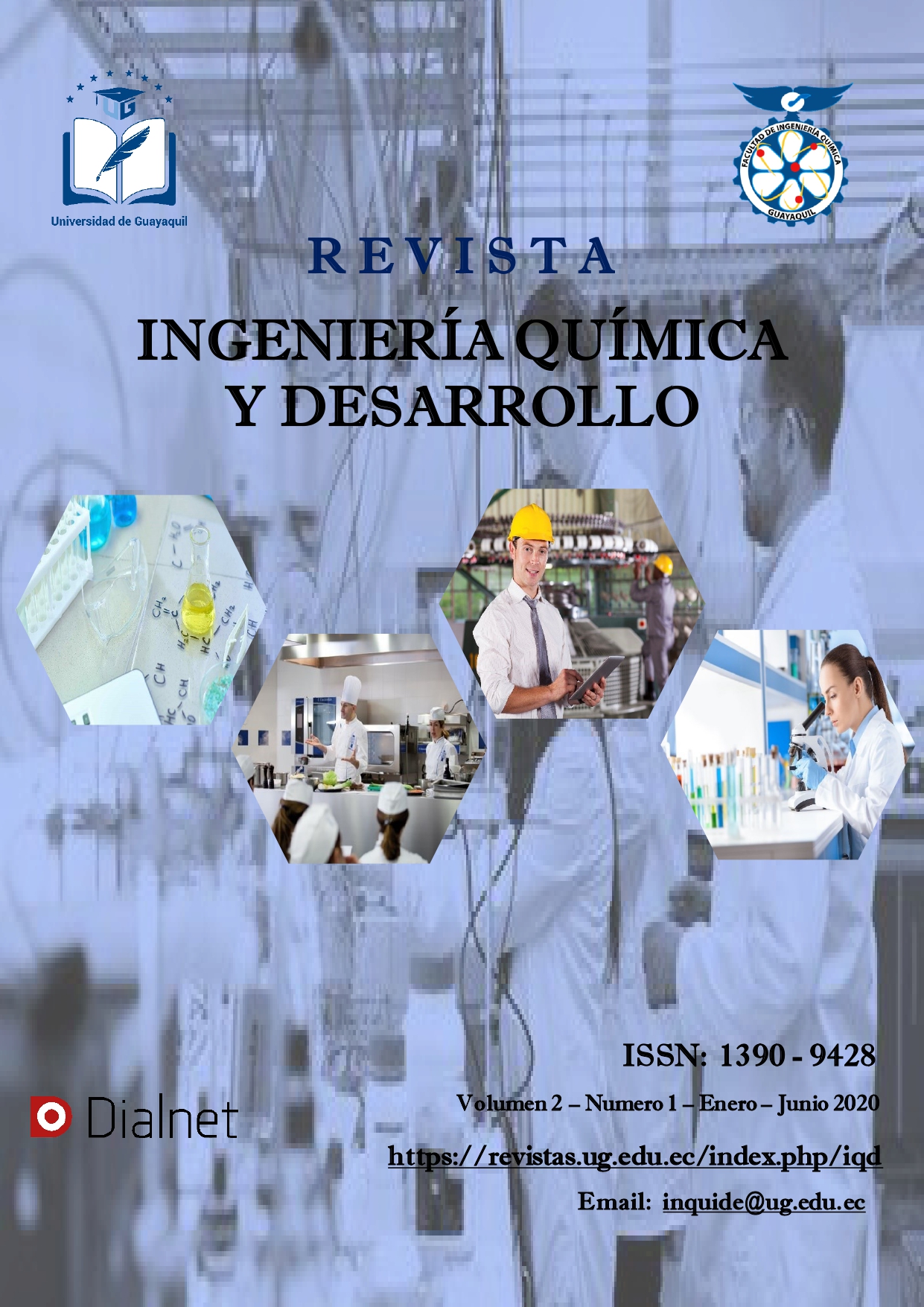Comparison of production costs and degree of pollution by emissions in the industrial sector of Ecuador using natural gas as fuel by means of process simulation.
Main Article Content
Abstract
In this investigation, the comparison of industrial costs and the degree of pollution due to emissions generated using traditional fuels, especially diesel, which is the most used in the Ecuadorian industry against natural gas through a program of Open source chemical engineering called DWSIM for the simulation of the chemical combustion reactions of diesel and natural gas as energy generators in the production processes of the Industries, in which it was evidenced that getting the same amount of energy can be obtained reduce up to 22.46% of carbon dioxide emissions to the environment using natural gas, a variation in production costs was also determined, which is a function of indirect manufacturing costs since in this element of costs Total production of fuels is found thus saving 3.9296% per month used natural gas as a fuel generator against diesel as traditional fuel
Metrics
Article Details

This work is licensed under a Creative Commons Attribution-NonCommercial-NoDerivatives 4.0 International License.
Esta revista provee acceso libre inmediato a su contenido bajo el principio de que hacer disponible gratuitamente investigación al publico apoya a un mayor intercambio de conocimiento global.
Usted es libre de:
- Compartir — copiar y redistribuir el material en cualquier medio o formato.
Bajo los siguientes términos:
- Atribución — Usted debe dar crédito de manera adecuada, brindar un enlace a la licencia, e indicar si se han realizado cambios. Puede hacerlo en cualquier forma razonable, pero no de forma tal que sugiera que usted o su uso tienen el apoyo de la licenciante.
- NoComercial — Usted no puede hacer uso del material con propósitos comerciales.
- SinDerivadas — Si remezcla, transforma o crea a partir del material, no podrá distribuir el material modificado.
Derechos de autor
Los autores que publican en Ingeniería Química y Desarrollo conocen y aceptan las siguientes condiciones:
- Los autores retienen los derechos de copia (copyright) sobre los trabajos, y ceden a Ingeniería Química y Desarrollo el derecho de la primera publicación del trabajo, bajo licencia internacional Creative Commons Atribución-NoComercial-SinDerivadas 4.0 que permite a terceros compartir la obra siempre que se indique su autor y su primera publicación esta revista.
- Los autores conservan los derechos de autor y garantizan a Ingeniería Química y Desarrollo el derecho de publicar el trabajo a través de los canales que considere adecuados.
- Los autores son libres de compartir, copiar, distribuir, ejecutar y comunicar públicamente la versión del trabajo publicado en Ingeniería Química y Desarrollo, haciendo reconocimiento a su publicación en esta revista.
- Se autoriza a los autores a difundir electrónicamente sus trabajos una vez que sean aceptados para publicación. No se permite el uso comercial de copia o distribución de contenidos, así como tampoco la adaptación, derivación o transformación alguna de estos sin la autorización previa de los autores y de Ingeniería Química y Desarrollo.
References
C. Portilla y A. Rangel, «Universida Pedagogica y Tecnologica de Colombia,» 2016. [En línea]. Available: https://revistas.uptc.edu.co/revistas/index.php/cenes/article/view/4148.
M. d. Ambiente, «Ministerio del Ambiente,» 2016. [En línea]. Available: http://www.ambiente.gob.ec/wp-content/uploads/downloads/2016/10/Convenios-Acuerdos-Tratados-Multilaterales-sobre-medio-ambiente.pdf.
«NRDC,» 2014. [En línea]. Available: https://www.nrdc.org/sites/default/files/latin-america-diesel-pollution-IB-sp.pdf.
REDIBEC, «REDIBEC,» 2018. [En línea]. Available: https://redibec.org/ojs/index.php/revibec/article/view/23/51.
G. Moreno, «El Comercio,» 2 Octubre 2019. [En línea]. Available: https://drive.google.com/file/d/1UVzf74L14GxYON6d78ceZIBCPYzaZy1z/view.
ONU, «NACIONES UNIDAS,» 2016. [En línea]. Available: https://treaties.un.org/Pages/ViewDetails.aspx?src=IND&mtdsg_no=XXVII-7-d&chapter=27&clang=_en.
MAE, «MAE,» 2013. [En línea]. Available: http://www.ambiente.gob.ec/mae-trabaja-en-programas-de-mitigacion-y-adaptacion-para-reducir-emisiones-de-co2-en-ecuador/.
OLADE, «Rol del gas natural en latinoamerica,» 2013. [En línea]. Available: http://www.olade.org/wp-content/uploads/2015/08/Rol-gas-natural-desarrollo-ec-soc.pdf.
ARCH, «Produccion Diaria de Petroleo y Gas Natural,» Marzo 2019. [En línea]. Available: https://www.controlhidrocarburos.gob.ec/wp-content/uploads/PRODUCCIO%CC%81N-DIARIA-DE-PETRO%CC%81LEO-Y-GAS-NATURAL-NETO-DE-CAMPO-A-NIVEL-NACIONAL-PRELIMINAR-DEL-28-10-2019.pdf.
Alicante, «Metodologia Experimental,» 2018. [En línea]. Available: https://glosarios.servidor-alicante.com/psicologia/metodo-experimental.
B. Nestor, 2018. [En línea]. Available: https://www.redproteger.com.ar/poder_calorifico.htm.
Engineeringtoolbox, «Procesos de Combustion optimos,» 2003. [En línea]. Available: https://www.engineeringtoolbox.com/fuels-combustion-efficiency-d_167.html?fbclid=IwAR2WOWr1_voWvfLjXvUO_fekLL3H6AFMdyl9_ZR_EWibLbAXYB_wURePfgQ.
ARCH, 2020. [En línea]. Available: https://www.controlhidrocarburos.gob.ec/precios-combustibles/.
CEUPE, «Centro Europeo de Postgrado,» 2019. [En línea]. Available: https://www.ceupe.com/blog/elementos-del-coste-de-produccion.html.
J. d. Andalucia, «Guia de apoyo para notificacion de emisiones en instalaciones de combustion,» febrero 2020. [En línea]. Available: http://www.juntadeandalucia.es/medioambiente/portal_web/administracion_electronica/Tramites/Vigilancia_Prevencion/Modelos/EPRTR/Modelos/Guias_apoyo/Guia_Ep1c_Centrales_Termicas_OtrasInstalaciones_Combustion.pdf.
G. Lopez, «Comparacion de los Costos de Produccion y Grado de Contaminacion por Emisiones en el sector Industrial del Ecuador usando como Combustible Gas Natural,» p. 60, 2020.





